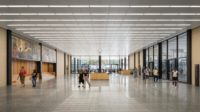Mecanoo Respectfully Revises Mies van der Rohe’s MLK Library

Situated at 9th and G Streets NW in Washington, D.C., the Martin Luther King, Jr. Library was designated a landmark in 2007, and is the District’s only built work by Ludwig Mies van der Rohe. Photo © Deane Madsen
Reopening last week after a three-and-a-half-year renovation, the Martin Luther King, Jr. Memorial Library once again has a dignity befitting the Washington, D.C. library system’s centerpiece building. The thoughtful reconfigurations and recalibrations, by Dutch firm Mecanoo and local practice OTJ Architects, hew to Modernist principles of the Ludwig Mies van der Rohe original, while gently layering in a softer, more humanistic touch.

Over the last two decades, the DC Public Library (DCPL) has quietly amassed a stunning portfolio of branch libraries throughout the District’s eight wards. Notably, in a city with a majority African American population, seven of which were designed by Black architects, including two by David Adjaye. Meanwhile the Mies library, opened in 1972 and named after the civil right leader, gradually became a neglected, albeit structurally sound, shell of its former self, losing its status as the system’s crown jewel.
In 2013, DCPL launched an architectural selection process, inviting teams to rethink Mies’s only library and his only built work in Washington. Winners Mecanoo and Martinez + Johnson Architecture (which subsequently merged with OTJ) proposed a respectful treatment of the four-story building—which was designated a landmark in 2007—and a tempered addition: a rooftop parklet capped with an optional multi-story bar of apartments. Pragmatic and financial considerations would later thwart the residential component, but the rooftop park has been realized, creating an elevated oasis in the heart of the city.

With a rectangular plan enclosed in a steel-and-glass curtainwall, the library was constructed as four masonry cores housing dark and cramped stairwells—a configuration that made the vertical circulation difficult to find. Between the cores ran corridors defined by beige brick walls, which had the effect of sequestering the staff in windowless offices. “All the shelving was in space where there was daylight, and all the people were behind brick walls in horrible rooms,” says Francine Houben, creative director of Mecanoo. Discovering that the masonry walls were structurally unnecessary, Houben saw potential of inverting that relationship by removing the masonry in favor of a more open plan ringed with perimeter seating, thereby bringing more light into the interior.

Mecanoo has left traces of the masonry partitions in flooring that demarcates their former position as well as with recessed cove lights where these walls would have met the ceiling. In opening up the interiors of the building to express its horizontality and structure, Houben suggests her team “made it more Miesian than it was.” It also satisfied the client’s desire for “a building that was easy to interpret from a legibility and program adjacency perspective” and would commemorate Dr. King’s life and activism, explains Richard Reyes-Gavilan, DCPL’s executive director.
Now, the movement of people is front and center, with a new monumental skylit stair exposed through a transparent glass wall that replaces a portion of original brickwork at the main entrance. The entryway glazing incorporates large-scale images of Dr. King speaking, made up of rounded pixels, which are patterned to look like civil rights and campaign buttons.
Inside the landmarked Great Hall, the orthogonal rigidity of Mies remains, and where Mecanoo’s interventions begin, the architecture acquires a soft curvature, rendered in vertical strips of light wood backed with black acoustical felt, that distinguishes new from original.

The bustle of street activity carries through to a lower-level creative zone with dance and recording studios as well as a fabrication lab replete with sewing, 3D printing, and other maker-space equipment. Children and teen libraries occupy the second level, with a stairwell-adjacent slide between the floors, visible from the street, further animating the interior. On the third level, a new double-height reading room, made by removing one bay of the floorplate above, offers a grand area for focused study. The fourth level houses the Library’s special collections and archival materials related to Washington at the building’s east and west ends, with the center occupied by a double-height auditorium; ascending to the top row of seating at its rear, visitors can exit to the roof-level garden and take in the city views.

Libraries have emerged as a specialty for Mecanoo. “I’m called the library whisperer in the U.S.,” jokes Houben. Among the firm’s projects are two renovations for New York Public Library (NYPL): the Stavros Niarchos Foundation Library (formerly the Mid-Manhattan Library), which opened in July with limited services due to the pandemic; and the Beaux-Arts Stephen A. Schwarzman Building (the NYPL’s main branch), where work is ongoing. Mecanoo also has three current library projects in the Netherlands, and another in Tainan, Taiwan. “A big part of the population still thinks a library is just storage for books,” says Houben. “But it’s much more about knowledge sharing: you can do that with books, lectures, through meeting other people and learning from each other in a space that is very inclusive.”
Some day in the not-so-distant future, visitors to the MLK Memorial Library will be able to take advantage of the full range of opportunities for this knowledge sharing that the building has to offer. But in this phase of the District’s reopening, access will be limited to the library’s main level for quick book check-outs, computer use, and new library card applications.





